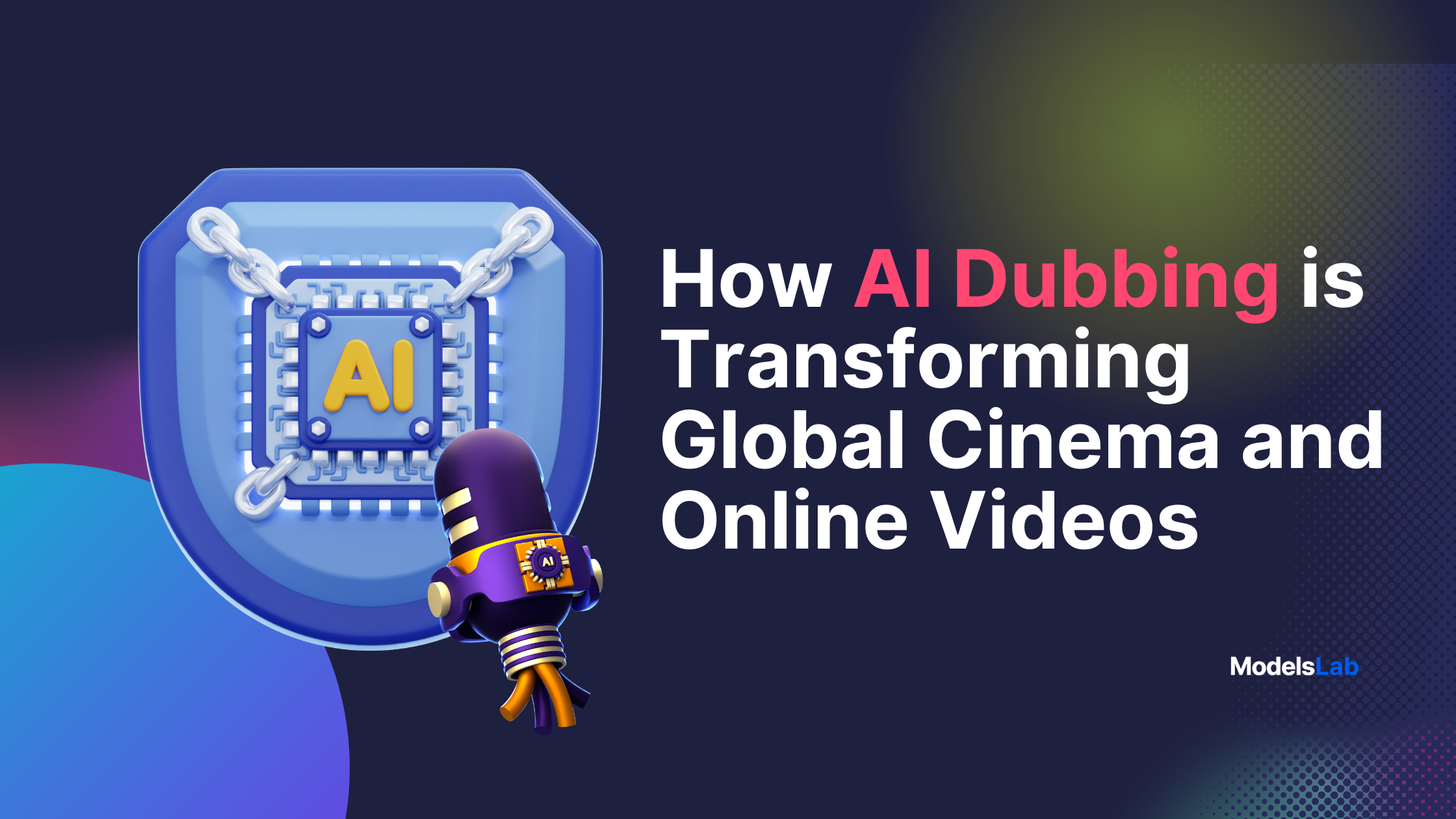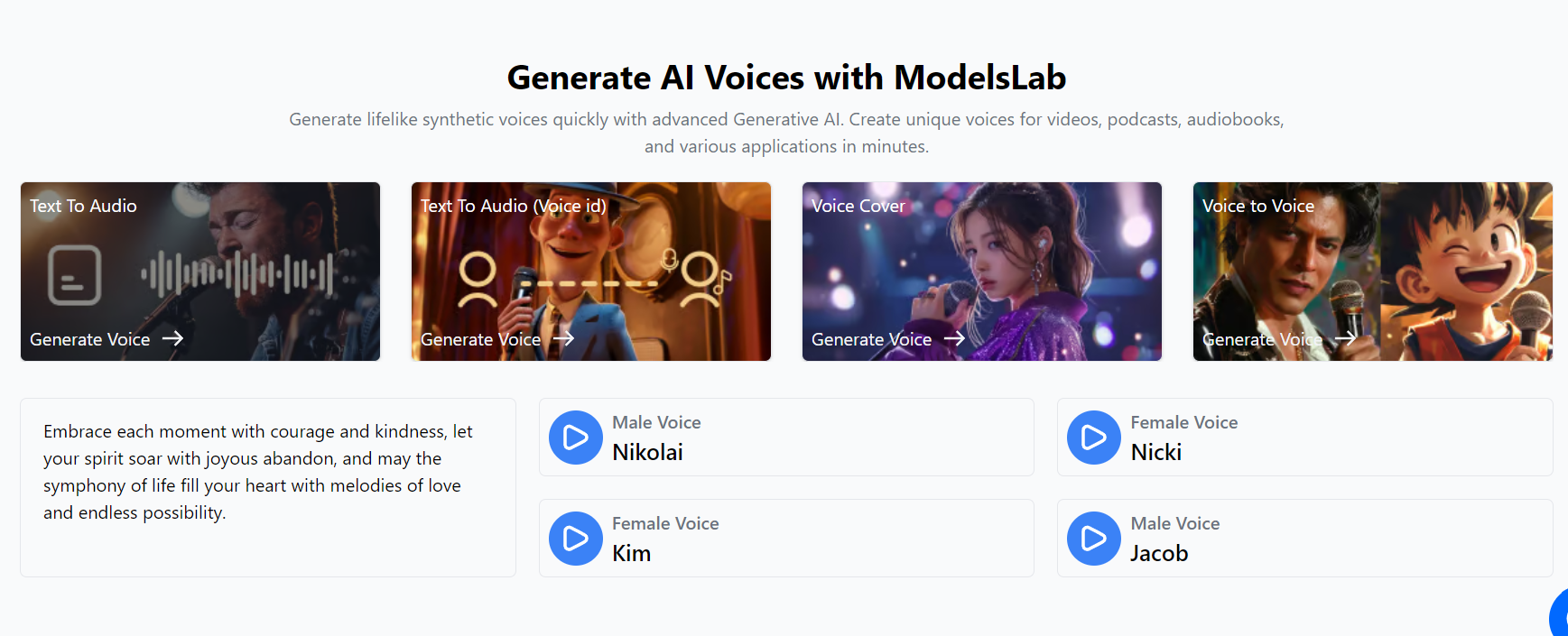Can AI Dubbing Translate Videos and Clone Voices Quickly?
Written on . Posted in AI.
Dubbing is a collaborative art that goes beyond mere translation, involving voice actors, directors, and sound engineers. But, With advanced AI video dubbing techniques, films can now break language barriers and translate your content to reach a global audience. This process not only preserves the movie's emotional essence but also respects cultural nuances.
The global dubbing market is booming, thanks to AI voice technology, making content more accessible and diverse through the use of voice in multiple languages. As AI dubbing evolves, it's transforming the industry by making the dubbing process more efficient and accessible for content creators and audiences alike, allowing them to translate and dub their videos seamlessly.
How Does the AI Dubbing Process Work?
AI dubbing streamlines the translation and voiceover process, making it more efficient and cost-effective. Here’s a breakdown of how AI dubbing operates, highlighting its role in replacing the original voice tracks with new voice options generated through text-to-speech technology.
Data Collection and Machine Learning
The process begins with gathering extensive linguistic data to train AI models for video dubbing, ensuring they can effectively translate and dub various languages. These models learn from diverse voice samples, accents, and expressions, capturing the intricacies of language and speech, which is essential for effective voice dubbing. Neural networks and advanced algorithms analyze this data to detect patterns and nuances.
Voice Profiling and Synthesis
AI then develops a comprehensive voice profile for each actor, ensuring that their original voice can be replicated accurately in different languages, enhancing the overall video with new ones. This profile captures unique characteristics like pitch, timbre, and emotional range, enabling AI to synthesize a voice that can speak in multiple languages while retaining the actor's original qualities.
Lip-Sync and Emotional Adaptation
The AI-synthesized voice is adjusted to sync with the actors' lip movements, ensuring that the dubbing looks and sounds natural, similar to traditional voiceovers, which is a significant changer in the industry. AI also modifies the emotional tone to match the scene’s context, making the dubbing expressive and accurate, similar to what a skilled video dubber would achieve in voice-overs, using natural-sounding AI voices.

Quality Control
The final step is quality control, where any discrepancies in timing, pronunciation, or emotion are corrected to maintain the integrity of the human voice in voice dubbing, ensuring the original audio is preserved. Human oversight is often involved to ensure the dubbing meets high industry standards, especially when compared to traditional dubbing methods, which may not utilize the latest AI technology for realistic voiceovers.
AI dubbing significantly enhances film localization, combining technology with artistry to provide a seamless, emotive global viewing experience, which makes content accessible to a wider audience and allows for the option to download your dubbed video.
Benefits of AI Dubbing in Movies
Incorporating AI dubbing into the film industry offers considerable advantages throughout the audio production process, from independent films to major franchises, including the use of advanced dubbing tools.
Cost Efficiency
For indie films with limited budgets, traditional dubbing can be prohibitively expensive, making AI dubbing a cost-effective alternative to upload your video and reach a broader audience. AI dubbing enables these films to be dubbed into multiple languages at a fraction of the cost, freeing up resources for other aspects like visual effects or marketing in online video platforms, while also allowing for real-time AI adjustments.
Quality Enhancement
AI’s precise voice modulation maintains the emotional pitch across languages, making it an invaluable tool for high-quality dubbing. In dramatic films, for instance, AI can replicate subtle voice tremors, ensuring the performance’s impact remains intact in every language, which is essential for effective audio and video localization.
Speed and Efficiency
In the fast-paced film industry, AI dubbing offers quick turnaround times, allowing simultaneous release in various markets and enabling the video’s audio to reach audiences worldwide. A Hollywood studio can leverage AI dubbing to release a film worldwide on the same day, maximizing impact and revenue through efficient video localization and the use of free AI dubbing tools that facilitate anyone can dub videos.
Try ModelsLab for better speed and efficiency!

Consistency
AI ensures the consistent portrayal of a character’s voice across all dubbed versions, preserving iconic traits like a distinctive laugh in high-quality audio regardless of language, making it a powerful tool for video and audio localization.
Multilingual Capabilities
AI dubbing not only translates words but adapts cultural nuances, ensuring that humor and language are effectively conveyed in the target language, making it the best AI tool for voice dubbing and providing realistic voiceovers.
Voice Preservation
AI can preserve an actor’s original voice, allowing for its continued use even after retirement, showcasing the capabilities of voice dubbing and the innovative voice cloning feature, which enables anyone to dub videos in 20+ languages. For instance, in "Rogue One: A Star Wars Story" (2016) and "Star Wars: The Rise of Skywalker" (2019), the voice of Grand Moff Tarkin was recreated using a mix of CGI and voice mimicry after actor Peter Cushing’s passing.
Challenges of AI Dubbing
While AI dubbing offers many advantages, it also presents challenges that need to be addressed to realize its full potential in the realm of voice dubbing and video localization, particularly in terms of making content accessible.
Cultural Sensitivity
AI may struggle with translating idioms or humor deeply rooted in the original language, posing a challenge for effective video localization and subtitle accuracy, which are frequently asked questions by content creators. Ensuring AI can navigate these subtleties requires advanced programming and cultural understanding, especially in the realm of video dubbing, to produce realistic voiceovers that align with audience expectations.
Voice Matching
Replicating an actor’s distinctive voice, such as a raspy quality, is complex and requires extensive AI training to ensure authenticity in voiceovers, highlighting the power of advanced AI in video creation.
Nuanced Acting
AI systems may not always capture the emotional depth behind a whisper or a sob, impacting the performance’s intensity and potentially leading to a need to replace the original voice tracks for better emotional resonance. In a thriller, for example, the subtleties of a whispered confession are crucial and must be accurately conveyed through high-quality AI dubbing to maintain suspense, making it a game changer in film production.
Voice Variation
Actors often change their voices to portray different emotions or characters. AI dubbing must adeptly adjust to these variations while maintaining consistency in high-quality voiceovers, using natural-sounding AI voices for an authentic experience.
Future of AI Dubbing
The future of AI dubbing is not only about refining existing capabilities but also exploring new possibilities in high-quality dubbing and generative AI applications that allow creators to download your dubbed video effortlessly.
Advancements in Machine Learning
Future AI systems will have an enhanced understanding of context, emotion, and cultural nuances, automatically adapting dubbing for cultural relevance, thus ensuring a wider audience can appreciate the content.
Deepfake Technology
Integrating deepfake technology with AI dubbing could allow actors to 'perform' in languages they don't speak, enhancing the film's authenticity and the quality of voiceovers, much like traditional dubbing methods.
Voice Banks
Actors might record their voices in various emotional states, creating a voice bank that AI can use to maintain consistency across a range of performances in online video content and voice overs.
Real-Time Dubbing
AI could eventually offer real-time dubbing for live broadcasts or streaming content, allowing viewers to select their preferred language in real time using an AI dubbing tool, transforming the video’s audio experience.
Personalized Experiences
Viewers could choose not just the language but the type of voice for characters, using AI voice dubbing technology to tailor the viewing experience to their preferences and enjoy audio descriptions in multiple languages.
Ethical and Employment Considerations
With AI dubbing's rise, the industry must address its ethical implications and impact on voice actors’ employment in the context of AI video production and the shift from traditional dubbing methods. Voice actors might transition to training AI systems, ensuring their skills continue to shape the dubbing process and enhance the quality of AI video projects through generative AI techniques.
Final Thoughts
AI dubbing goes beyond just being a tech innovation. It connects global audiences to diverse stories by translating and dubbing content with ease. This technology simplifies movie production, breaking down language barriers and opening up new markets for content creators. It's transforming the industry by making films more accessible to everyone.
As AI dubbing advances, it's set to revolutionize the film industry by making stories resonate with audiences everywhere, regardless of language. This technology is unlocking huge growth potential, ensuring movies can connect with viewers worldwide, and making content more inclusive and far-reaching.
FAQs
What is AI dubbing for movies?
AI dubbing for movies involves using artificial intelligence to recreate a film’s audio in different languages, and using machine learning to synthesize voices that match the original actors’ tone, pitch, and emotional delivery.
Can AI be used for dubbing?
Yes, AI can be used for dubbing by analyzing voice data and creating synthetic voices to deliver dialogues in multiple languages, making the process faster and more consistent, akin to a professional video dubber.
How is AI used in movies?
AI is used in movies for scriptwriting, editing, visual effects, and predictive analytics, leveraging AI algorithms to enhance various aspects of production and viewer engagement.
What are the benefits of AI dubbing in films?
AI dubbing offers cost efficiency, quality enhancement, speed, consistency, and multilingual capabilities, making it a valuable tool to dub your video in film localization and reach audiences worldwide.
